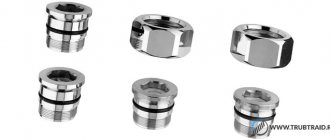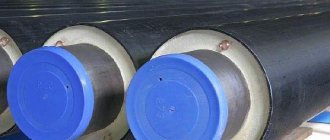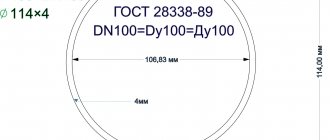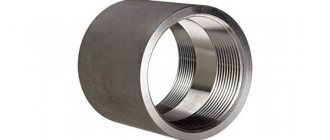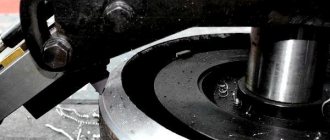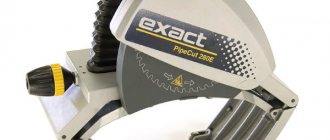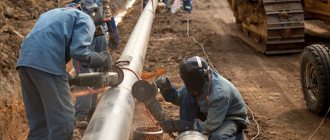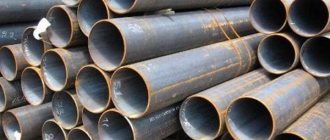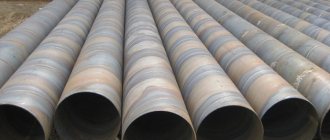Menu:
- Steel pipes: types of joints
- About threaded joining of steel risers
- Connection methods
- How and what to seal pipe joints with
- Types of seals, sealing methods
- Materials for sealing joints
- Threaded pipe connections: pros and cons
- General thread requirements
- Malleable cast iron and connecting parts made from it
- Video
All pipelines are installed according to the pipeline system designs. When laying metal pipes for heating, gas and water supply (cold and hot water), it is necessary to connect the fittings and risers.
The quality of functioning of the gas pipeline, water supply system, and heating system, which is designed to use steam under pressure or hot water with temperatures up to 95 - 100⁰C, depends on the reliability of the articulation of the elements of the pipeline.
The optimal temperature range according to GOST heating systems is up to +60⁰С, depending on operational, climatic and other factors.
Steel pipes: types of joints
Steel pipe connections can be permanent or collapsible, depending on:
- materials from which the risers are made. In addition to metal pipes, cast iron, glass, polymer, and copper products are used;
- properties of transported media;
- operating conditions.
Most often used:
- coupling (threaded, welded, bayonet, sleeve);
- flanged;
- threaded
Disconnect joints. Let's focus on the last option.
About threaded joining of steel risers
The threaded connection method is typical for working with steel pipes. To apply threads, use a lathe or die. Cylindrical rolling threads are applied to thin-walled risers.
If the installation rules are followed when laying steel pipes, then twisting in this way will ensure high-quality functioning of the pipeline for many years.
Screwing using threads can be carried out either by directly connecting pipes to each other, or using tees, couplings, shut-off valves, and additional devices.
Connection methods
Threaded and non-threaded connections can be of a collapsible or non-separable type. Many are confident that any structure with threads can be disassembled.
If one end of the risers is welded to a fixed surface, then such a pipe device cannot be disconnected. This option is a typical example of a permanent threaded connection.
But such cases are rare. The main number of twists using threads is of the detachable type.
The risers are connected to each other using:
- sweeps;
- bidirectional thread.
Squeegees are used to twist pipes that are motionless relative to their own axes.
Required condition
: one riser must have a long thread cut, and the second a short one.
To connect in this way, first screw the locknut with the coupling onto the long thread. After this, you need to drive the coupling onto a section of the pipe with a short thread, and then tighten it with a lock nut.
The technique of using bidirectional threads is that only a coupling is used to join pipes. It must be screwed onto both risers simultaneously.
Important! When using bidirectional threads, the pipes being connected must be threaded in different directions. Only in this case will the coupling tighten the pipes, and the twisting will be high-quality, reliable, and durable.
DIY assembly
Fastening heating pipes to supporting structures (in an open manner) using special fasteners can be done quite quickly on your own when carrying out repairs.
Quite often, wiring requires cutting walls with laying pipelines into prepared recesses. This method is most often used during the construction phase.
Required tools and materials
For the purpose of installing heating, welding generators, various types of soldering irons, sets of adjustable wrenches, and sealing materials for threaded connections (tow, fumlente, paste) can be used. Joining metal-plastic parts and cross-linked polypropylene pipes may require special crimping tools. The most cost-effective way to lay heating pipes is to connect polypropylene pipes. The only special equipment required is a soldering iron with nozzles of 20, 25, and 32 sizes, which can be purchased for 1000-1500 rubles.
When using foil-reinforced pipes, a shaver may be needed to clean the ends, the cost of which does not exceed 700 rubles.
Drawing and diagrams
Heating is always installed on the basis of preliminary calculations with the drawing up of plans and diagrams. Design determines all subsequent technological operations, so this stage should be treated with special attention.
At the design stage, it is necessary to decide on the wiring diagram, which can be one- or two-pipe, horizontal or vertical, dead-end or with counter-movement of the coolant. Quite popular in low-rise construction is the wiring diagram, called “Leningradka”.
Work order
All installation work must be done in stages. Each stage corresponds to a certain preparation, including calculations, acquisition of parts, and marking of the elements to be connected. To connect polypropylene thermal sections it is necessary:
- cut and strip parts of the pipeline to the required length and prepare fittings;
- install a nozzle of the required diameter on the soldering iron;
- heat the soldering iron to a temperature of 260 degrees. Celsius;
- for a few (5 to 9 seconds) seconds, place the pipe and the element to be connected on the appropriate nozzle in order to melt the polyethylene layer;
- combine the elements and compress until they “set” when cooling;
- connect the sections with the installed heating equipment, perform rigid fixation using fasteners.
How and what to seal pipe joints with
Types of seals, sealing methods
To prevent leakage of the pipeline working fluid, it is necessary to properly seal the pipe twists.
When threading steel pipes, the following are used as seals:
- gasket This method of sealing a threaded connection requires relatively thick end pipe cuts. The presence of smooth pipe ends can never ensure tightness. When using a rubber or plastic gasket, this problem is successfully solved. This option is ideal in case of articulation using a union nut;
- winding The materials can be linen strands, polymer threads, FUM tapes in combination with hardening sealants, paints, pastes.
When installing plastic risers, a sealing method is used based on the deformation properties of the material. The essence of this method is that a plastic pipe with an external thread is screwed into a riser with an internal thread. During deformation, plastic contributes to excellent filling of the intermediate space, eliminating the appearance of gaps.
When it comes to pipeline structures with high pressure, cylindrical threaded pipe connections are not entirely appropriate here. In such cases, a conical type connection is used. The principle of connection is that when screwing in, the pipes are tightly pressed until the gap completely disappears.
Materials for sealing joints
To make the joint impenetrable, the following are used as seals:
- flax (tow);
- asbestos;
- FUM tape;
- natural drying oil;
- whitewash;
- minium;
- graphite lubricant, etc.
A reliable sealant when twisting steel pipes onto threads is strands of flax impregnated with red lead or white lead. This connection is easy to install and reliable in terms of sealing. The seal has been used for a very long time and does not lose its popularity today, despite the emergence of artificial analogues.
For those who have little experience in installing fittings and pipes, we suggest that under no circumstances use flax without paint.
At first, the joint will not allow moisture to pass through. But several months will pass, the flax fibers will get wet and begin to decompose. Therefore, the quality of all connections will deteriorate, and in another month or two, water will leak at the junction.
Important! The fibers must be thoroughly impregnated with red lead or whitewash so that not a single dry strand remains.
When operating pipelines with a working environment temperature higher than the boiling point of water, the best sealant option is asbestos thread together with flax strands. To do this, they are impregnated with a mixture of graphite and natural drying oil.
Important! You need to coat the joint with the strands first with red lead, and then with whitewash, and not vice versa.
Before use, the strands are combed out so that the fibers can be separated well.
Important! The strands must be wound “behind the thread” and then soaked with paint. If you lay the tow against the cutting direction, then when screwing on the coupling it will all come out to the sides and you will have to start all over again.
Important! To avoid clogging of the risers, you need to ensure that the tow does not hang from the end or get inside the riser.
Many people use FUM tape, which is in no way inferior to old traditional materials - tow with paint.
Sometimes there is no tightness at the junction of the risers. To eliminate this defect, you need to replace the sealing material, and clean the threaded area from dirt and sealant residues. After this, rewind the linen thread, FUM tape or other sealant, and assemble the structure.
Pastes and sealants of chemical origin are used as additional sealants, which will help strengthen this section of the pipeline.
Advantages and disadvantages of each method
Thread
Advantages:
- reliability;
- ease of assembly, possibility of disassembly;
- low cost.
Flaws:
- tension in the thread cavities increases material fatigue, reducing its strength;
- the need to use locking means to prevent the working element from unscrewing.
Flanges
Advantages:
simplicity and convenience of reusable connection and disconnection.
Negative properties:
- high labor intensity in manufacturing, therefore, high price;
- with prolonged use, the location of its connection decreases, loss of tightness.
Bonding
The advantages of this method include its not labor-intensive process, which does not require much skill and effort.
But the wait for gluing sometimes reaches three days, which is not always convenient.
This type of connection cannot be considered a reliable method.
Welding
Advantages:
- reliability;
- durability;
- tightness;
- the ability to connect parts of any shape.
Flaws:
- the occurrence of residual stresses;
- possibility of changing geometry;
- risk of destruction under vibration and shock loads.
Trumpet
In comparison with all types, socket pipes have the advantage of low cost, the possibility of small axial and lateral movements of the pipe, which is very useful during temperature changes and soil shrinkage.
The negative indicator lies in the difficulty of connecting the connector and insufficient reliability at high pressure.
Pressing
A common positive factor is excellent self-centering of the joined parts and stable state under shock loads. A simple and non-labor-intensive process.
Cannot be disassembled or dislodged from each other. Here are a few disadvantages of this method.
Methods for connecting metal pipes
Threaded pipe connections: pros and cons
The option using threads has its advantages and disadvantages.
On the positive side, threaded connections differ:
- versatility, which consists in the fact that they can be used for twisting risers of various diameters;
- ease of installation, since to carry out the articulation procedure you do not need to be a professional or have any special knowledge. It is enough to have basic skills in handling a wrench or pipe wrench, or other simple skills in this industry;
- lack of sets of special tools or devices;
- resistance to loads, reliability in operation;
- ease of dismantling the entire pipe structure (if necessary);
- tightness, which is ensured by the presence of sealing materials and compliance with basic rules for laying pipelines.
Flaws:
- if there is no thread on the parts, it is necessary to apply it, which can cause additional difficulties, since not everyone has the skills to cut it and not everyone has sets of special tools;
- when the joints have to be frequently mounted and dismantled, rapid wear of the threaded section of the line part is possible;
- There are times when it is necessary to lock the threaded part, since the fitting may gradually unscrew itself.
Taking into account all the pros and cons, in some situations the best option is to use a threaded connection of steel pipes, and in others, other types of joints of pipeline structure elements. This means that there is no ideal way to connect steel risers: all methods are good if they ensure reliability and tightness of the pipeline.
Important! When choosing a method for joining pipe structures, take into account what material the pipes are made of, the location of the possible connection of parts, operating conditions of the pipeline, and what properties the joining of elements of the pipeline system should have.
Important! For galvanized pipes, only a threaded connection is suitable, since during welding work the galvanization will be damaged, after which the riser will be easily exposed to corrosion.
Connecting metal heating pipes without welding
The fastest connection method without welding is a compression fitting. However, we will consider other methods: threaded connections and installation of a repair and mounting clip. The latter is used both for joining and eliminating leaks caused by metal cracking.
Thread
It is possible to create a threaded connection only if there is free access to the pipe, i.e. at the initial installation stage. In other cases, thread cutting will be quite problematic or impossible. The procedure itself is carried out according to the following scheme:
General thread requirements
The connections are used at the joints of steel heating pipes, water pipes, and gas risers, where welding can be avoided. On ordinary risers, the thread is cut, but on thin-walled products it is applied by rolling.
Main requirements:
- Correctly, well-cut threads must be clean;
- the thread is considered defective if it is torn or incomplete;
- the length of the thread should not be more than one tenth of the length of the part;
- on couplings, it should be of such a size that when the ends of the pipes are fully screwed in, a gap of up to 0.5 cm remains between them (this is the so-called short threaded connection);
- When twisting “one cylinder onto another cylinder”, they use bends. A bend is a piece of pipe with threads on both ends with a coupling and lock nut screwed onto them.
Important! A high-quality squeegee should have a long thread at one end (22-27 threads), and a short thread at the other (5-7 threads).
The advantage and versatility of this part is that it is used if the risers are fixed and cannot be rotated.
Pipe selection
The specific operation of heating circuits also determines the characteristics of the lines used. It is the pipelines that ensure the reliable connection of all devices and elements, forming a single system.
Pipes for heating circuits vary according to the manufacturer, raw materials used, and a number of technical parameters. In the production of pipes for heating networks, various structural materials and their combinations can be used, but it is customary to distinguish several main types.
Plastic
In the production of plastic highways, various types of polymers can be used: polyethylene, polypropylene, polybutene, polyvinyl chloride and other innovative plasticizers based on polyfinyls. The use of polymer pipelines is justified only in low-temperature, low-pressure circuits.
To give plastic components the necessary strength characteristics, polymers are usually used in their production in combination with some kind of reinforcing component.
Polypropylene
Most thermal systems use reinforced polypropylene pipes. This is due to the fact that polypropylene has a relatively high coefficient of linear expansion when heated. The main reinforcing components are aluminum foil and fiberglass. The main purpose of reinforcement is to prevent pipelines from deforming when heated. In addition, there is no need for a large number of expansion joints over long sections.
Solid or perforated aluminum foil between layers of polypropylene perfectly protects the heating main from destruction under the influence of oxygen and significantly increases its service life.
Cross-linked polyethylene
Another type of plastic pipelines are coolant channels made of cross-linked polyethylene. The polymer received its name because of the production method in which the process of cross-linking the links of ethylene molecules occurs.
Pipes made of cross-linked polyethylene are designated PEx and stands for: PE - polyethylene, and the index “x” indicates cross-linking. Sections made of cross-linked polypropylene bend well and are resistant to mechanical loads, so they are often used when laying hidden heating circuits for heated floors.
Steel
Pipelines made of steel pipes are giving way to more progressive and less costly types of organizing heating systems. However, almost all apartment buildings, industrial and administrative buildings of old construction have heating systems based on metal pipes.
Steel components of heating networks can withstand relatively high pressures and temperatures, so in some cases their use cannot be avoided.
In private homes they are used less often, but are excellent for laying main pipelines.
Malleable cast iron and connecting parts made from it
The most common ductile iron parts for connecting steel pipes and other pipeline parts are: A) straight couplings B) reducing couplings C) coupling nuts D) fittings E) locknuts E) plugs.
To completely seal the system with a threaded connection, it is necessary to use sealants, for example, gaskets. In addition to them, for other types of fastening additional parts are used. If it is necessary to connect the elements of the pipeline using flanges, that is, without a coupling, then in addition to gaskets, bolts are also needed.
When connecting risers at an angle, they use connecting parts made of ductile cast iron: straight and transition angles, tees, crosses.
Important! The connection will be of high quality and function flawlessly for a long time if, when installing parts, you use parts with straight ends that will be placed at right angles to the connecting parts.
You should pay attention to the threads on the parts, which should be free of burrs and clean.
A cast iron coupling has a low collar around the entire perimeter of the end circumference, which serves to increase the strength of the part, unlike its steel counterpart, which does not have such an element.
The quality of connections depends not so much on the sealing methods and materials, but on the craftsman and the quality of his work. If he is responsible, neat, has basic plumbing knowledge and skills in working with a wrench or pipe wrench, then you won’t find a better specialist. If you follow the basic rules for installing pipeline systems, the pipeline will function for many years. This can be confirmed by anyone who has at least once installed a pipeline system, even the shortest and simplest one.
Try it yourself, experiment and see that you are the best specialist in installing pipeline systems using the threaded method of connecting pipeline elements.
Classification of couplings for polypropylene pipes
The pipe line is not necessarily elements of the same diameter, made of polypropylene. There are many options when it is necessary to connect products of different materials and diameters into one network.
Today, several types of polypropylene couplings are produced, with the help of which pipe sections with diameters of 20-110 mm are connected.
Classification and features:
- if products of the same diameter are connected - straight couplings;
- for structures of different diameters - transitional;
- installation of pipelines made of various materials, for example, steel and polypropylene - combined models are suitable.
According to the type of connection, such connecting elements are divided into:
- detachable;
- one-piece.
By connection option:
- welded;
- compression
By functional features:
- repair;
- connecting;
- protective.
To connect the first two options (direct, transitional), soldering technology is used, for which a special tool is used - a soldering iron. Such couplings can withstand pressures up to 2.5 MPa and temperatures up to +95°C.
The marking must indicate the diameter. If this is a transitional model, then two indicators are noted. For example, MP 40x32. That is, with the help of this element you can connect polypropylene pipes with a diameter of 40 and 32 mm.
Combined models allow you to connect pipes made of polypropylene and other materials. They are also suitable for joining with shut-off valves. For this purpose, a steel thread is inserted into their design. It can be external or internal.
It is the ability to connect steel and polypropylene elements with each other that is the advantage of combined couplings for polypropylene pipes.
